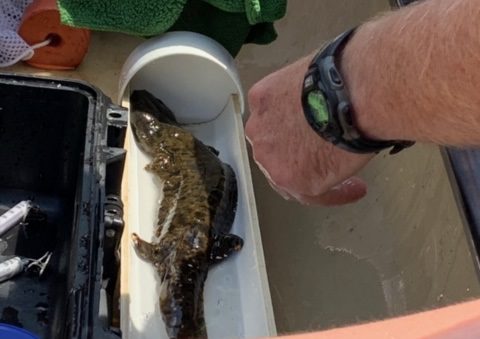Hellbenders offer a window into water’s health

Hellbenders – a species of large salamander with an evocative name – can tell us something about the health of a river.
That’s why I took a week off to volunteer with the NC State Parks system, helping with hellbender surveys in the New River northwest of Charlotte, in Ashe County. Hellbenders are salamanders that live under rocks in clean, swift-moving rivers in eastern North America. Their brown, black and green marbled patterned backs blend in perfectly with their underwater surroundings. They can grow as long as 29 inches and can weigh up to five pounds.

Volunteers looking for hellbenders in the New River. Photo: Crystal Cockman.
Macroinvertebrates are good indicators of water health across the state. Insects, crustaceans, molluscs, and arachnids can all tolerate water quality in different degrees. Mayflies, caddisflies, stoneflies, hellgrammites are all highly sensitive to pollution. Their presence anywhere indicates good water quality. Dragonflies, damselflies, crayfish and clams are somewhat tolerant of pollution. Black fly larvae, lunged snails, and leeches are all pollution-tolerant.
So even though the Charlotte area is not home to hellbenders, the rivers and streams of this area still have similar bioindicators that help scientists determine water quality. Hellbenders are just a larger version of these other “canaries in a coal mine.”
Over the course of the week, we found 23 hellbenders and two mudpuppies, another salamander species. We even found what may be the largest hellbender ever caught in North Carolina, at around two feet long. The survey various courses of the south fork of the New River, some shallow and slow-flowing, others deep and fast-moving.
So what does conducting a hellbender survey entail? There are several jobs associated with this activity, and for most of the time this year I helped with the seine net. This is set up behind large rocks, which “lifters” will raise up with peaveys and cant hooks. Still others will don goggles and gloves and search under those rocks, feeling around for the critters. The seine is there to catch any hellbender that might escape. Lifters and divers have to be very careful – the lifters yell “set” when they have the rock stable, and then the divers will yell “clear” when they are done searching.
When a hellbender is caught, a runner takes the animal, keeping it in a small bag and holding it in the water as they carry it to the data boat. This canoe houses a PVC pipe cut in two where the animal is submerged in water and measurements are taken. The creature is weighed, then measured for length and examined for any parasites, injuries, or abnormalities. We determine if the animal is male or female, then check it with a device to see if it is one we’ve captured and tagged before. If not, then we’ll insert a pit tag and write down the number associated with it.
This whole process is done as quickly as possible, keeping the animal shaded with cloths and wet the entire time. One of the team members identifies the rock where the animal was found with a buoy affixed to a brick, and the runner will carry the hellbender back to that rock and let it go so the critter can slide back under to his safe spot.

Volunteers measuring a hellbender on the New River. Photo: Crystal Cockman.
These ancient creatures have been around since the time of dinosaurs, but some estimate that their population may have decreased by as much as half in recent years. They breathe through their skin and are heavily impacted by pollution of our rivers and waterways. The New River is already on the borderline of being cold enough for them to live, as they need very cool and clean water. The eastern hellbender is a species of special concern, and a subspecies called the Ozark hellbender found in southern Missouri and northern Arkansas is federally listed as endangered.
Although some locals consider them a bad omen, their presence is really a great indicator of good water quality. Much of the New River is designated as National Wild and Scenic River, as well as being an outstanding resource water, which is the highest water quality designation the state of North Carolina gives waterways. New River State Park has acquired a number of tracts along the river and works with local land conservancies to acquire additional parcels when they become available. Continuing to protect this important stretch of river is good not just for the hellbenders, but for all the creatures that use this resource – and for the people who rely upon it as well.
The last day we went back and finished up a couple stretches we weren’t able to complete due to storms and other factors, and we caught two more hellbenders before 1 p.m. The last one we caught escaped from those who were searching for him under his rock, and it took about 10 minutes for someone else to come up with him. They usually stick pretty close to their rock even when disturbed, so it is rare for one to get away from us entirely.
Most of these creatures go their whole lives without ever being seen by humans, so if you do find a hellbender while kayaking or fishing, consider yourself fortunate and leave them in their aquatic home. They are a unique critter and an important part of the riverine ecosystem.
Crystal Cockman is the land preservation director at Three Rivers Land Trust.